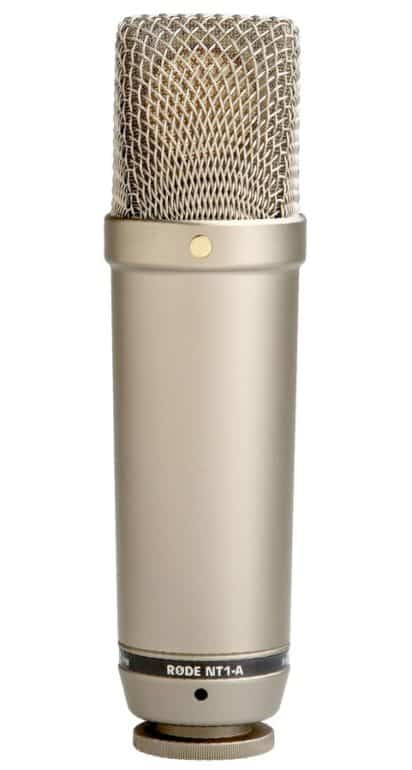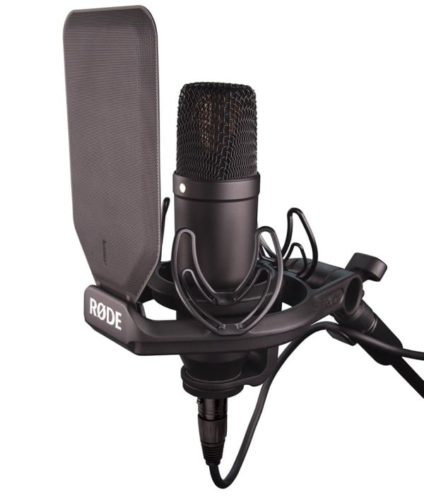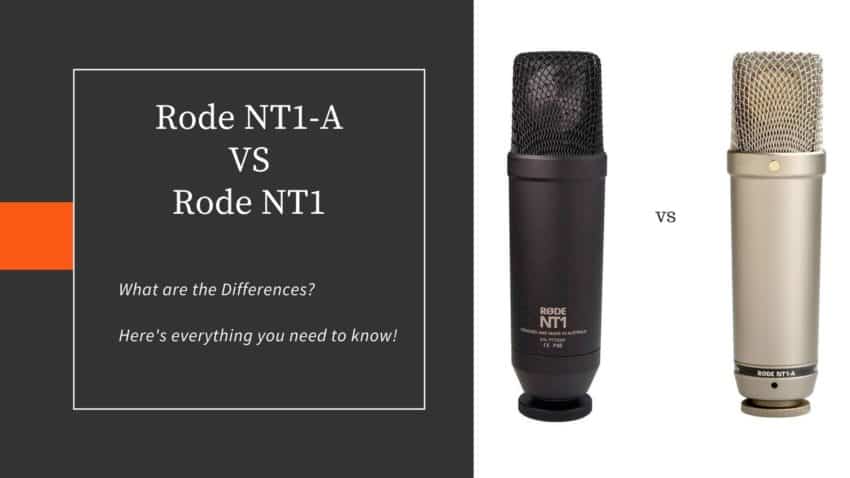Last updated on December 30th, 2023 at 02:52 pm
Both the Rode NT1-A and the NT1 are two of the best-known microphones in the recording industry.
You probably won’t find a single recording studio without at least a couple of them.
But what are the differences between both of them? And which one should you choose, if you decide to purchase one?
In this post I will give you a brief overview of both of them, as well as their differences.
Lastly, at the very end I will also give you my opinion on which one I consider to be the best alternative for most people.
Let’s get started…
Rode NT1-A

The Rode NT1-A is one of the most famous and used microphones in the recording industry.
Some people praise it as if it were the best microphone to be ever created and they even compare it to other ones that are in a much higher price range.
The reason why the Rode NT1-A is so good is because it will give you a very accurate representation of what is being recorded, meaning that it should easily fit within any mix.
It has a very natural sound, even though after reading some reviews online I found that people complained about it having a bit of a harshness, or high frequency/presence boost, which is actually quite common on microphones at this price range.
However, this all depends on your specific taste, since every microphone will have its own character.
Some people might find that it enhances their voice, while others may find that it makes their voice sound absolutely horrible and shrill.
Now, as far as the build quality goes; I honestly can’t complain at all!
It’s absolutely fantastic and it’s built to last.
Sadly, the Rode NT1-A doesn’t come with a PAD or High–Pass filter, it’s just the bare microphone, but it is a great performer and it does what it’s supposed to do.
It has a slight boost at around 150Hz and at the 6k to 12kHz range, with a deep cut at the high-end;
All this means that it will be actually quite bright sounding, which is what I referred to earlier by saying that people found it to be a bit harsh at times.
How does it Perform?
I found it great for recording vocals, acoustic guitar and electric guitar, but to be honest… once you get to this level of microphones it gets hard to really find one that doesn’t really do what it’s supposed to.
It all comes down to your own preferences, what kind of tone you’re going for, etc.
I actually do like the high-end boost a bit since it gives it a more “airy” sound, although maybe not so much on MY vocals, but like I mentioned earlier, it all comes down to the source you are recording.
This is also something that works well with acoustic guitars, since that high-end boost really opens up the higher frequencies, making the guitar sound better.
As I mentioned earlier, it all depends on your personal taste.
Pros
- The build quality is fantastic.
- The shock mount is metal, when most included ones are made of plastic.
- It’s insanely quiet (Low self-noise).
- Open and Airy high-end.
- Can Handle high SPL.
Cons
- The presence boost could make your recordings too bright potentially. It can also you make your vocals a bit more sibilant.
- The included cable isn’t the best one.
- No PAD or HPF.
What comes in the Box?
- The Rode NT1-A microphone.
- A Storage Pouch.
- You also get the shock mount which comes with a pop filter already attached.
- And lastly you get an XLR cable.
Specifications
- Polar Pattern: Cardioid
- Frequency Response: 20Hz – 20kHz
- SPL: max 137dB
- Impedance: 100 Ohms
- Sensitivity: -32dB
- Self Noise: 5dB
Find out more about the Rode NT1a here:
- Rode NT1a: Amazon, Sweetwater.
Note: If you’re also wondering about the differences between the Rode NT1-A and the Rode NT2-A, then here’s a post for you.
Rode NT1

The Rode NT1 is the newer and updated version of the famous NT1-A which was released almost 14 years prior.
It’s been completely redesigned from the ground up and the only component both of these microphones share is the mesh grille.
The sound quality is absolutely fantastic.
It has a fairly flat frequency response whith just some rounded cuts at 20-30Hz and 16k-20kHz.
Overall, the Rode NT1 has a full tone without having a boomy low end, plus the high-end sounds really bright without being “shrill” or anything.
As you would expect, the build quality is just as good as the one of the NT1-A; the body is all metal and so is the grille, which doesn’t have any give to it whatsoever.
One cool thing about the NT1 is that it comes with a shock mount and the best pop filter I’ve ever seen, since it has two layers instead of just one, which is much better at dispersing the plosives than conventional pop filters.
The only issue with this pop filter is that it has to be mounted directly onto the shock mount, which means that it can only be used with the Rode NT1.
The Rode NT1 can run on both 24v and 48v Phantom Power.
Sadly, just like the NT1-A, this one doesn’t feature a PAD or a high-pass/low-cut filter, which isn’t too big of a deal since all of this can be done from the recording software.
How does it perform?
In all honestly, I like the NT1 a bit better than the NT1-A.
However, like I mentioned previously while talking about the NT1-A, this all depends on your taste and the source you are recording since no microphone is good at recording everything.
The NT1 sounds a bit darker than the NT1-A, and this is because it doesn’t have that boosted high-end.
In my particular case, I like the way the NT1 records my vocals a bit better.
When recording acoustic or electric guitars, it does a phenomenal job as well.
Everything sounds clear, the low end isn’t boomy at all, the high end is defined but not too exaggerated while still sounding airy.
Basically, the Rode NT1 has a much flatter sound than the NT1-A because of the flatter frequency response.
It doesn’t feature as much of a high-end boost, which is what gives the NT1-A its distinct characteristic.
Pros
- Best Pop filter ever included.
- Shock mount is of great quality.
- Great Build Quality.
Cons
- Sometimes more sibilant than other microphones.
- No PAD or Low-Cut Switches.
What comes in the Box?
- The Rode NT1 Microphone.
- A Microphone Pouch.
- The shock-mount.
- And the Pop Filter.
Specifications
- Polar Pattern: Cardioid
- Frequency Response: 20Hz – 20kHz
- SPL: 132dB
- Sensitivity: -29.0dB
- Self Noise: 4.5dB
Find out more about the Rode NT1 here:
- Rode NT1: Amazon, Sweetwater.
Differences between the Rode NT1-A and the NT1
The Rode NT1-A features a much brighter and open sounding high-end because of the high frequency boost, which opens up those frequencies giving them a much more “airy” feel.
On the other hand, since the NT1 has a much flatter frequency response, it sounds darker and flatter because it doesn’t feature as much of that high-end boost.
Which one should you choose?
I personally prefer the Rode NT1, but only because I think that the increased high-end of the NT1-A doesn’t compliment my voice as much as I would have hoped.
But like I already mentioned a couple times, it all depends on your personal taste and the source you’re trying to record.
This is why I don’t think that there is a clear winner here, even though I prefer the NT1.
I think that if this is your first microphone, then you should go with the NT1;
Having a flatter frequency response means that it will be easier for you to get it sounding how you like it.
In both cases, you can EQ afterwards and fix what you don’t like, which obviously isn’t ideal, but since both microphones are of such good quality, it can absolutely be done.
Conclusion
No matter which microphone you choose, believe me that you’re getting a top-quality one.
Both of them are built like a tank, they sound amazing and they are used in thousands of recording studios around the world, so what’s not to like?
Like I already mentioned, I prefer the NT1 and I also believe that it’s the better choice for most beginners…
But again, each one sounds slightly different and will also compliment the source differently, which is something you need to take into consideration.
If you feel like a brighter- more open high-end is what you need, then go with the Rode NT1-A.
On the other hand, if you want a flatter sounding microphone, then the Rode NT1 would be your best bet.
I hope this information was useful.
Have a wonderful day!

I have an NT-1 for a podcast and love it. I saw an NTK for sale in Arizona, it had to be dry there, for a reasonable price. It looked brand new and came with all of the accessories. Including the ultra-rare, I Love Rode stickers! I absolutely love the warm, tube sound it puts out. My website bringAmic.com is under construction right now. Soon to be up and running. Thank you for your rear world examples in your reviews and suggestions. Maybe some more interfaces? Keep up the good work.